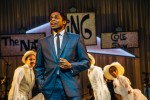It’s hard to say that one can fully understand what’s going on inside a man’s mind. But “Lights Out: Nat ‘King’ Cole” attempts to do just that.
In the ’40s and ’50s, Nat King Cole (Dulé Hill) was known as a smooth-singing, confident musician who became famous not only for his musical talent but also for his legendary charm. Households across America sang along to his songs as they sat glued to the television watching his variety show: “The Nat King Cole Show.”
What viewers at home were not privy to, however, were the dramatic measures taken to ensure Cole’s show would be palatable to white American households. In the 1950s, this meant ensuring that physical distance existed between Cole and white women on the show at all times. It meant makeup artists applied powder to Cole’s face to lighten his complexion. It meant Cole could often only include African-Americans into roles they traditionally held, such as cooks or athletes, rather than astronauts or businesspeople. But even with the carefully crafted, white-friendly measures, Cole’s show did not survive the entrenched racism and discrimination of 1950s America, and low viewership led to its demise.
“Lights Out,” running through March 24 at the Geffen Playhouse, portrays the final night of “The Nat King Cole Show.” The play delves deep into Cole’s emotional state as he tries to balance his famously cool persona with the reality of being an African-American man in show business. Throughout the show, absurdist scenes emphasize historical and social commentary – a compelling method of underscoring the importance of recognizing and confronting American racism.
Absurdism, in particular, stands out in a dizzying and almost outrageous tap dance battle between Cole and his on-stage buddy Sammy Davis Jr. (Daniel J. Watts). Davis’ energetic and sharp character implores Cole to shed his unbothered facade and communicate his experiences of internal conflict to the audience. The conflict comes to a head through an impressively choreographed and well-executed tap dance battle that exemplifies how absurdism helps the play portray the intricacies of the mind. The quick back-and-forth dancing between Cole and Davis perfectly reflects Cole’s inner turmoil.
Set in 1957 – Dec. 17 at 7:44 p.m., to be exact – the script still uses modern language and references, occasionally referring to events that have yet to occur, such as specific 21st century acts of police brutality against African-Americans. At times, the references were distracting and hard to follow, but they ultimately helped the play point out America’s racism, both past and current. Notably, the historical references tended to move chronologically, starting with mid-20th century examples, such as the murder of Emmett Till, and progressing toward modern instances, helping guide the audience.
A poignant moment referencing modern race relations comes during what seems to be an imaginary fever dream of Cole’s. In it, a young African-American woman is being held in a chokehold by a white man and calls out, “I can’t breathe!” This reference to the 2014 death of Eric Garner helped demonstrate the persistence of racism in America. The actors surrounding Cole overwhelm him with different movements, and Hill looks obviously overwhelmed and dizzied by what is going on in front of him. For the viewers who catch them, the allusions serve as moving reminders, but the references could have been made more explicit to further their impact.
Although the play deals with heavy social commentary, the dialogue also balances humor and lightheartedness, particularly through the character of Davis. One of the most enjoyable scenes comes at the beginning of the play, when Davis delivers a monologue describing his love for attention. His quick wit and spastic nature, demonstrated when he runs quickly from one corner of the stage to another, provide moments of laughter in the midst of the serious social critiques. At one point, he even interrupted the show to sing happy birthday to two audience members, keeping the theatergoers on their toes each time he was on stage. Further, the play is sprinkled with vaudevillelike performances in which performers sing and dance in a traditional 1950s way, further establishing the historical setting.
In the form of a upbeat and jaunty vaudeville performance, “Lights Out” provides astute social and historical commentary through an examination of the psyche of Cole. Growing progressively more serious, the stirring musical performances and hyperbolic representations of life in the 1950s provide a moving commentary on modern racism. The heavy nature of the topic is not overwhelming, and the grand dance numbers and humor balance the play well. After all, where else in Los Angeles could one watch Nat King Cole and Sammy Davis Jr. in a tap dance battle?
